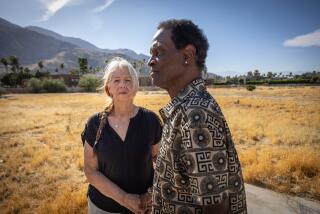Commune’s Flower Power Wilts to the Temptations of Prosperity
- Share via
ARROYO HONDO, N.M. — For sale: a piece of the ‘60s, a page of hippie history.
After three decades, the New Buffalo commune--the haven for flower children that was depicted in “Easy Rider”--is on the market.
For $1 million, a buyer can get 52 acres, a 15-room house, a couple of outbuildings and unlimited nostalgia.
“It’s been a big part of my life--but I just want to move on,” said Rick Klein, who bought the land north of Taos in 1967.
Klein and his wife, Terry, watched New Buffalo evolve from a cluster of tepees in a meadow to a struggling, back-to-the-land commune to a dairy farm to a ramshackle rental property.
In its most recent incarnation, the Kleins--after much renovation--operated it as a bed and breakfast for 3 1/2 years, drawing visitors from around the world.
“People treated it like it was a pilgrimage,” said Rick, sitting in the large, round, mud-plastered room that is the hub of the main house. Behind him on the wall were remnants of the era--a tattered American flag, a psychedelic painting.
New Buffalo got its start when Rick used inherited money to buy a 94-acre tract in the beautiful Arroyo Hondo valley, then donated it to the commune.
Hippies flocked to the site.
“New Buffalo was almost like Mecca,” recalled Brigid Meier, who is handling the property for Dreamcatcher Real Estate Co. in Taos. She first heard about the commune while living in San Francisco in 1967.
“If you got to New Buffalo, you had made it.”
It was an austere life, as commune members built adobe dwellings and tried to feed themselves by growing their own food.
There was sex, and drugs, and rock ‘n’ roll--”but mostly it was working on these old trucks,” Rick said.
He left New Buffalo after about a year and moved to nearby Lama. He felt awkward about his role as benefactor and wanted to spend his time making music, not farming. But he and Terry returned regularly for the “great, fantastic parties.”
New Buffalo’s visitors over the years included such figures as counterculture icon Ram Dass and drug guru Timothy Leary.
“I painted a sign on the wall that said Timothy Leary may have slept here--but then again, he may have stayed up all night,” Terry said.
Actor Dennis Hopper, who directed and starred in the 1969 film “Easy Rider,” was also a visitor. According to Rick, Hopper wanted to film part of the movie at New Buffalo but the commune--already weary of publicity--nixed it, and the scene was filmed at a set elsewhere.
In various forms, New Buffalo functioned as a commune for more than 15 years.
“I think it could have worked had it been financially more stable,” said Lisa Law, a photographer who captured its early days while living briefly in a tepee on the site and in later visits.
“The idea of being together and being a big family, a big tribe, was a great idea,” Law said.
Law chronicled the era in a book and a video, “Flashing on the ‘60s.” The Smithsonian Institution’s Museum of American History will exhibit 63 of her photos in a show that opens Oct. 17.
The Kleins regained ownership of the property about 1989, made substantial improvements--including indoor plumbing and a new roof--and began running the B&B; at the end of 1992.
The guests included members of the original commune and their children.
“Someone would say, ‘I was born in such-and-such a room.’ Or, ‘Do you know who my father was? I know I was conceived here,’ ” Terry said.
One day a small group of tattooed, black-leather-clad Japanese bikers showed up--and went through their repertoire of Grateful Dead tunes.
The devastating fire in May 1996 in Lama, in which the Kleins lost their house and possessions, prompted some soul-searching. New Buffalo became a temporary shelter for displaced Lama families, and the Kleins decided that they no longer wanted to devote full time to a bed and breakfast. He is writing a book.
“It’s great to look back . . . but like Rick says, you can’t hold up the ‘60s for everybody,” Terry said.
The Kleins have already given some of the original property to their two sons, and deeded more to a local land trust. They got permission to subdivide the remaining acreage, if necessary, into several parcels.
But they much prefer to sell the land intact, envisioning it as a school or a spiritual retreat center.
“Some time, some day, this building could be on the National Register of Historic Places,” Rick said. “It really is culturally significant.”
More to Read
Sign up for Essential California
The most important California stories and recommendations in your inbox every morning.
You may occasionally receive promotional content from the Los Angeles Times.













